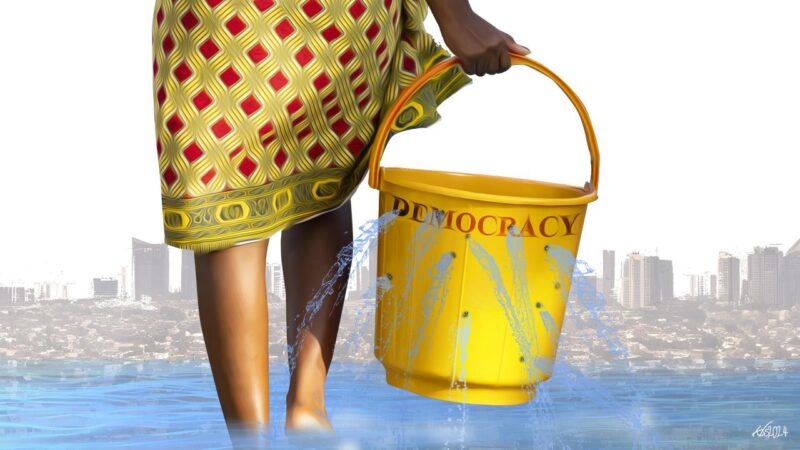One of the ideas I have looked at as a possible solution to the challenges of small-holder agriculture is cooperatives, where farmers can pool together capital and share resources such as irrigation infrastructure, markets, knowledge, etc. And we have seen this work—dairy cooperatives are one of the more successful small-scale agribusiness set-ups in East Africa—for obvious reasons. If we extend the cooperatives idea further, and we are met with dedicated farming zones.
I define a dedicated farming zone as just that—an area dedicated to agriculture. The land holding can vary from small to large scale, owned either privately or communally. It is not subject to subdivision for settlements as it is purposely set aside as agricultural land. The dedicated farming zone may have built-in irrigation systems, machinery for hire, established labour sources and marketing routes. One of the best examples I have seen is the Mwea rice irrigation ecosystem.
The Mwea rice irrigation ecosystem
I will not go into the history or the current set-up of the irrigation scheme here. Moreover, in this article, I deliberately use the word “ecosystem”—and not “irrigation scheme” as it is typically known—to broaden the lens of the discussion from the historic irrigation scheme to the direct and indirect consequences on the rest of the Mwea region. Also, I have cherry-picked the best of the principles that make the Mwea irrigation ecosystem work. However, like any system, it has its challenges and problems, which I do not cover here.
Land consolidation, tenure and ownership
The genius of the irrigation ecosystem is how the agricultural land is separated from residential land. You live wherever you want, but the farming land is for farming only, protecting it from unnecessary subdivision for sale or inheritance.
The farmland itself has inherent agricultural value. For the most part, it makes economic sense to cultivate it instead of setting up real estate as is typical in other regions of the country. It also helps that much of the farmland has a high water table that is suitable for establishing rice fields—constructing or living on this land would be impractical.
As a potential farmer, you can choose to lease. And if you are a land owner, you can rent out part or all of the land. Land becomes a valuable resource for crop production with a fixed value such that whatever you put into it in terms of investment, the returns at the end of the year are fairly predictable.
Rice is grown in two seasons (can be more). The first season repays the farmer’s crop production expenses (seedlings, inputs, mechanization). After the first harvest, rice is left to regenerate to yield a second harvest. A common saying in the area is that the second harvest is the farmer’s profits.
This predictability in input and output makes farming attractive as an investment. You know how much to put in and the returns to expect at the end of the year with a certain degree of certainty. Compare this to rain-fed agriculture where low-yielding seeds and unpredictable rains expose the investment to external risks.
A common saying in the area is that the second harvest is the farmer’s profits.
Farmers are not charity workers—they will farm if it makes financial sense for them. With the risks and unpredictability of rain-fed agriculture, it is no wonder farmers are increasingly shying away—the losses accruing every year are too much.
Shared farm machinery
When we talk of mechanization as a challenge for small-scale agriculture, it is from the angle of affordability. But where demand is high, investors may take up the risk of buying the equipment to earn money from hiring it out. This is the case for the Mwea ecosystem, which depends on machinery for land preparation, harvesting and packing the rice straw into bales for hay.
Due to the risks of manual harvesting in rice paddies, it is much more economical to hire harvesters than pay for human labour. This means machines are available to every farmer, keeping costs low. The same goes for packing bales—a machine will pack rice straw for every single farmer in the ecosystem. There is work throughout the year with short down times. Low costs also translate into low production costs overall and assure better profits for the farmer. It is a win-win situation.
Government intervention
Small-scale farmers require a certain level of government support. It can be in the form of provision of credit facilities, improved seeds/seedlings, extension officers, etc. However, it has to be the right amount and mix so that farmers are still able to decide when, where and how to farm.
In the Mwea ecosystem, farmers obtain seedlings from the National Irrigation Board (NIB). A farmer can prepare their own seedlings but this is a time-consuming process; It is more efficient to obtain high-yielding and improved seedlings from the board.
Besides seedlings, NIB also oversees the use and management of water in the irrigation canals (these are separate from the farms that use surface/groundwater due to high water table). Known locally as the water committee, the NIB ensures fairness in the use of irrigation water, maintains the canals and expands or changes their course if need be.
The NIB also plugs in to offer storage for the produce at a fee and a factory to mill the rice. This is an alternative for those that do not wish to use a private store or mill.
The right mix and amount of government intervention are important. In the past, the NIB would get involved in the production capacities of the farmers. Chaos ensued, particularly during the harvest season; the rice the farmers harvested belonged to the NIB and farmers had to wait for it to pay them less the cost of seedlings and inputs. However, the “liberalization” of this ecosystem gave farmers more control over their farm produce and allowed growth of new parties within the ecosystem such as the financier middlemen. I wonder if this same method could help tea and coffee farmers earn more from their produce.
The Financier middleman/broker
In the course of my research I was surprised to learn about the financier middleman/broker within the rice production ecosystem. A figure of both love and hate in Kenya’s agriculture sector, the middleman exploits farmers, yes, but they also address an important gap—market and logistics. The Mwea ecosystem middleman, a role filled mostly by women, goes a step further to provide soft loans to farmers.
The broker buys rice from the farmers, mills it, stores it and sells it to wholesalers and other retailers, and also directly to consumers in smaller quantities. When a farmer wants to cultivate rice but lacks the money, they approach a broker who provides a soft loan. The broker dictates the conditions of the loan including the return period, and fixes the price of the rice they will buy from the farmer after harvest. Your work as a farmer now becomes to grow and harvest enough rice to pay off the loan and still have enough left over for your own needs.
The “liberalization” of this ecosystem gave farmers more control over their farm produce and allowed growth of new parties within the ecosystem such as the financier middlemen.
Some brokers obtain funds from financial institutions. In this way, banks indirectly extend credit to farmers through these traders. And this is very interesting because one of the many challenges of small-scale farming is access to loans. What can you do at the farm if you lack the initial capital? Not much. Farming is an investment venture with capital needs, operation and production expenses and risks. Every venture needs financiers and the Mwea ecosystem has self-corrected to build up its own financiers.
I cannot speak to how well the system works, how conflict is resolved and the instances when defaults happen, but it is an interesting idea for future research.
Social proof for the cultivation of other crops
Rice production is the main activity in the Mwea region. However, farmers have also taken up other crops on privately-owned land parcels and crops such as bananas, sweet potatoes, maize and beans are common.
The farmers have taken the lessons from the rice farming ecosystem and incorporated them into the cultivation of other crops. Canals are dug from the main water channels to bring water into the farms and from here the farmers use hose pipes or dig furrows to bring the water into the individual plots.
Water conservation and other good agricultural techniques are applied. For example, it is common to see bananas grown in Zai pits, beans in heavily mulched furrows and large plantations of maize growing in soils rich in organic matter—all under irrigation. What might have started as an irrigation scheme for rice has also impacted how farmers produce other types of crops.
Beyond the farm ecosystem
Beyond rice, the ecosystem offers other benefits. It provides employment opportunities at every stage of rice farming, use of inputs, processing (milling) and sale and distribution. The factories mill the rice and may be involved in the storage of the farm produce as it awaits sale. Farmers are allocated space for storage which they pay for. The factories also provide employment to dozens of people.
After the rice is harvested the rice straw is packed into bales to be sold as hay for mulching, fodder or animal bedding. The husks from the milling process are used as ingredients in the animal feed manufacturing process. Both provide additional income for the farmer and even more employment opportunities.
The farmers have taken the lessons from the rice farming ecosystem and incorporated them into the cultivation of other crops.
Moreover, new industries have formed around the Mwea ecosystem. When we talk about industrialization in Africa, do we imagine it from the perspective of creating completely new factories to supply consumer goods or to process agricultural produce? Think about it.
What can we learn from the Mwea irrigation ecosystem?
Based on the factors above, I am of the opinion that this is the way forward for small-scale agriculture in Kenya, if not in Africa. Combining land parcels prevents fragmentation and subdivision so that agricultural land remains so.
Land parcels can be “donated” by individual farmers so that each dedicates a portion of their land (bordering with other farmers) to increase the acreage under production. This land is protected from unproductive fragmentation by its inherent agricultural value. And this is incredibly important as we move into a future of increased urbanization and explosive population growth.
Besides contributing small parcels to make up a large parcel of land, dedicated farming zones can be created in arid and semi-arid areas where the population density is low.
By creating a farming zone, the farmers can pool together their resources to invest in mechanization and irrigation infrastructure such as boreholes, canals, furrows or drips that can easily be shared among farms, along with the costs of setting up.
As a collective, their access to markets and transportation options is also better. And should they wish to own the tail-end of the supply chain by selling to consumers, then there is room for this as well.
Farmers co-learning from each other solves the problems of farmer education and creates the social proof required for replication by other farmers; this is why farm models work.
Farm models demonstrate best practices for cultivating a certain crop or crop mix on a piece of land belonging to a farmer involved in that activity. For example, maize farmers in a given area can donate a parcel of land where the model is set up and all the farmers in the region can learn from it.
As my friend and Twitter user Nicholas Aburi says, it is not useful to lump agricultural inventions and best practices into the annual Agricultural Society of Kenya exhibitions/shows. Create instead farm models within walking distance where farmers can learn from each other.








